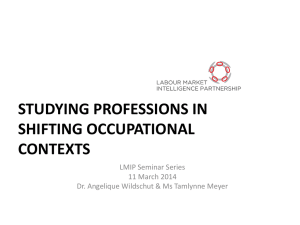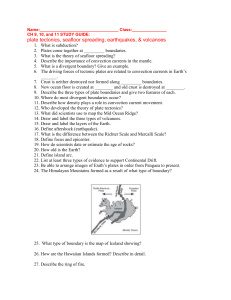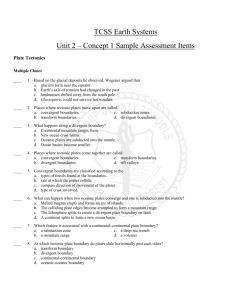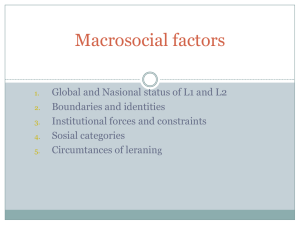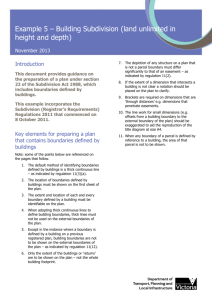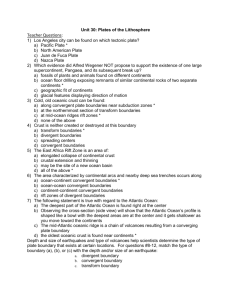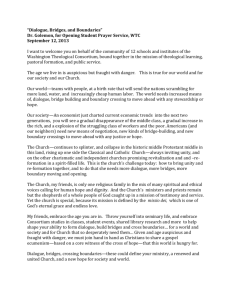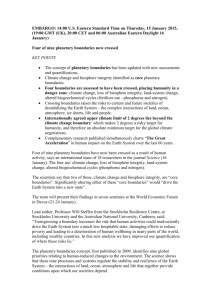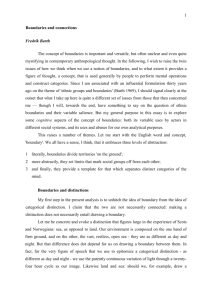Transgressing Earthly Boundaries - NexGen Global Forum
advertisement
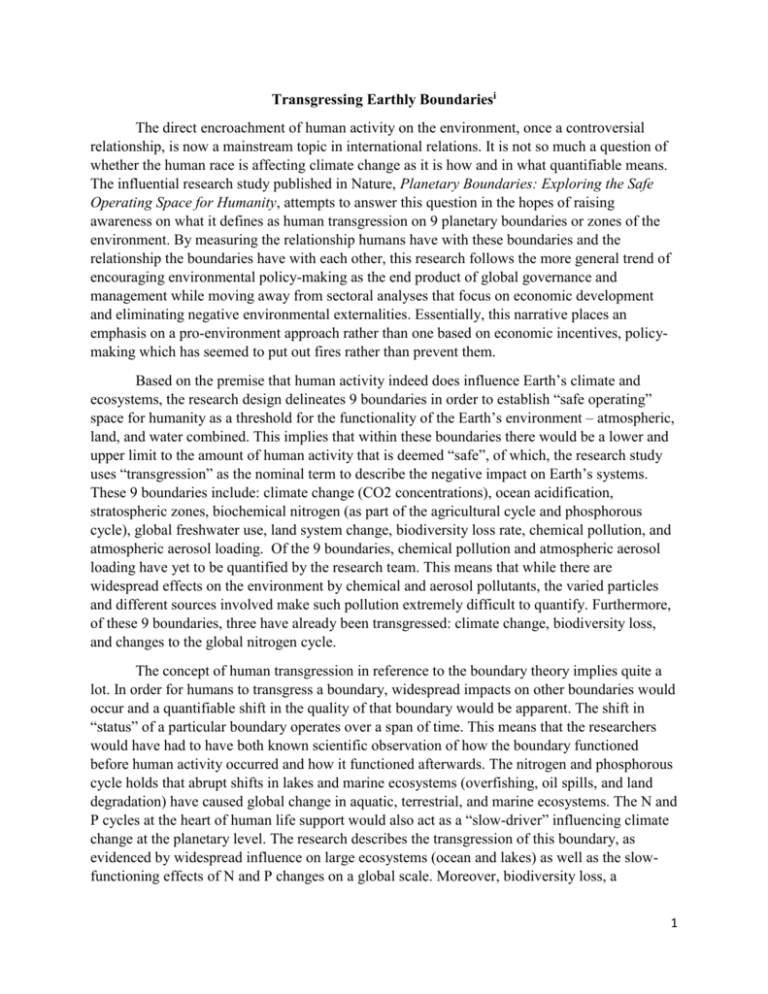
Transgressing Earthly Boundariesi The direct encroachment of human activity on the environment, once a controversial relationship, is now a mainstream topic in international relations. It is not so much a question of whether the human race is affecting climate change as it is how and in what quantifiable means. The influential research study published in Nature, Planetary Boundaries: Exploring the Safe Operating Space for Humanity, attempts to answer this question in the hopes of raising awareness on what it defines as human transgression on 9 planetary boundaries or zones of the environment. By measuring the relationship humans have with these boundaries and the relationship the boundaries have with each other, this research follows the more general trend of encouraging environmental policy-making as the end product of global governance and management while moving away from sectoral analyses that focus on economic development and eliminating negative environmental externalities. Essentially, this narrative places an emphasis on a pro-environment approach rather than one based on economic incentives, policymaking which has seemed to put out fires rather than prevent them. Based on the premise that human activity indeed does influence Earth’s climate and ecosystems, the research design delineates 9 boundaries in order to establish “safe operating” space for humanity as a threshold for the functionality of the Earth’s environment – atmospheric, land, and water combined. This implies that within these boundaries there would be a lower and upper limit to the amount of human activity that is deemed “safe”, of which, the research study uses “transgression” as the nominal term to describe the negative impact on Earth’s systems. These 9 boundaries include: climate change (CO2 concentrations), ocean acidification, stratospheric zones, biochemical nitrogen (as part of the agricultural cycle and phosphorous cycle), global freshwater use, land system change, biodiversity loss rate, chemical pollution, and atmospheric aerosol loading. Of the 9 boundaries, chemical pollution and atmospheric aerosol loading have yet to be quantified by the research team. This means that while there are widespread effects on the environment by chemical and aerosol pollutants, the varied particles and different sources involved make such pollution extremely difficult to quantify. Furthermore, of these 9 boundaries, three have already been transgressed: climate change, biodiversity loss, and changes to the global nitrogen cycle. The concept of human transgression in reference to the boundary theory implies quite a lot. In order for humans to transgress a boundary, widespread impacts on other boundaries would occur and a quantifiable shift in the quality of that boundary would be apparent. The shift in “status” of a particular boundary operates over a span of time. This means that the researchers would have had to have both known scientific observation of how the boundary functioned before human activity occurred and how it functioned afterwards. The nitrogen and phosphorous cycle holds that abrupt shifts in lakes and marine ecosystems (overfishing, oil spills, and land degradation) have caused global change in aquatic, terrestrial, and marine ecosystems. The N and P cycles at the heart of human life support would also act as a “slow-driver” influencing climate change at the planetary level. The research describes the transgression of this boundary, as evidenced by widespread influence on large ecosystems (ocean and lakes) as well as the slowfunctioning effects of N and P changes on a global scale. Moreover, biodiversity loss, a 1 representative transgressed boundary, will have massive effects on the Earth’s system, affecting the vulnerability of boundaries including a change in ocean acidity with species elimination and a change in terrestrial agriculture. This adds to another element to the human transgression definition: the limit to which the Earth can sustain a change in the boundary. At the current stage in Earth’s history, the article posits the earth will experience functional collapses due to current levels of biodiversity loss. Ocean acidification, however, is not a transgressed boundary, because although it is at risk, the researchers admit there is a “lack of time-series data” for the change in acidity as well as captured responses of marine life on CO2 or N and P cycle agitation. The reasons for the research are clear and positive. The boundaries serve as a way to understand Anthropocene impacts on the environment in an organized and scientificallyinformed way. Because of the use of time as the mechanism with which to measure transgression, the article implies that a transgression that does not persist too long can not only prevent functionality collapse, but potentially improve boundary conditions. Humans have the ability to change undesirable effects on the environment. The focus on the environment and the mechanisms by which the Earth functions, whole-heartedly supports the emphasis on global governance and partnerships as means to ameliorate environmental issues. The potential problems are glaring. Much is not known about how these boundaries interact with one another, which may cause researchers to exaggerate or underreport the effects of human activity. At best, the article expressed a confidence of three quantifiable boundaries while tentatively suggesting four more. Additionally, the research begs the question: how long can one boundary be transgressed before others are immutably affected? The challenge is clear and daunting. Humans would need to be actively engaged in understanding the effects of economic policy, development, and cultural practices on the threshold of each boundary in order to prevent long-term sociopolitical and economic dysfunction. The research implications of this paper argue strongly for an expedient response by policymakers towards creating an adaptable and unique global governance approach to the environment. i Planetary Boundaries: Exploring the Safe Operating Space for Humanity. Rokstrom et al. Ecology and Society.org, Copyright 2009. 2


